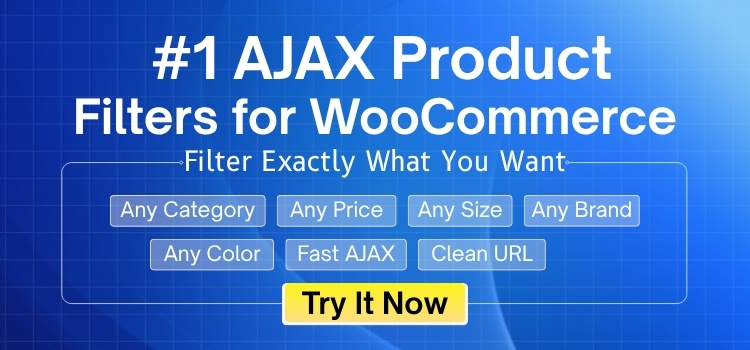AJAX product filters are dynamic tools that allow users to refine product searches instantly without reloading the page, creating a smoother and faster shopping experience. But a common concern among WooCommerce store owners is, are AJAX product filters safe for WooCommerce sites.
Yes, AJAX product filters are generally safe for WooCommerce sites when using reputable, regularly updated plugins. They enhance the user experience with instant filtering, but poorly coded or outdated plugins can pose security and performance risks. Always choose trusted plugins and keep them up to date to maintain a secure and efficient online store.
In this article, we’ll dive deeper into the benefits, risks, and best practices to help you make informed decisions about using AJAX filters on your WooCommerce site.
Are AJAX Product Filters Safe for WooCommerce Sites?
Yes, AJAX product filters can be safe for WooCommerce sites, but there are a few important things to keep in mind. These filters help users quickly find what they want without reloading the page. That sounds useful, right? But like anything on the internet, it depends on how it’s built and used. Let’s find out what makes AJAX Product Filters safe for WooCommerce sites.
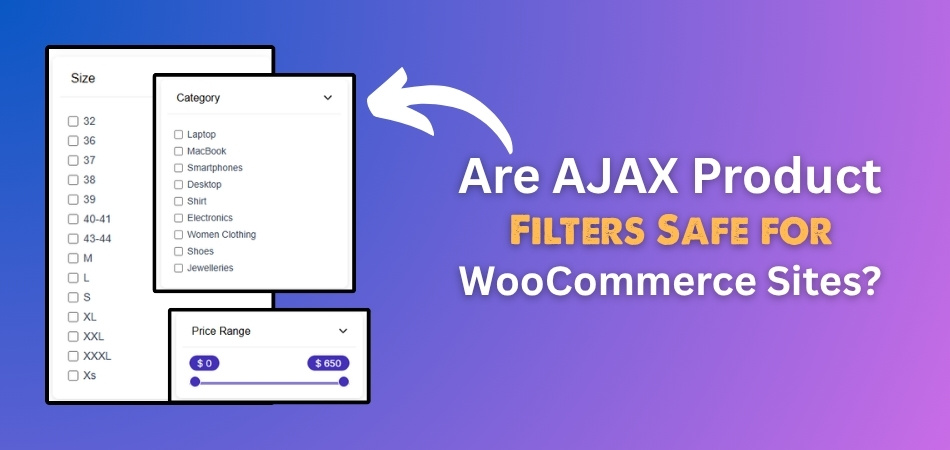
What AJAX Filters Do
AJAX product filters let customers sort or search products without refreshing the whole page. It gives a smooth and fast shopping experience. For example, if someone is looking for shoes under $50, they can apply a filter and see results instantly. This saves time and makes browsing easier. It’s one of the main reasons online stores love using them.
Choose Good Plugins
Not all plugins are built the same. Some are made by trusted developers, while others may not work properly. A poorly made plugin can slow down your website or even create bugs. It’s a smart move to go for Dynamic AJAX Product Filters for WooCommerce that are well-reviewed and regularly updated. Always check ratings and updates before installing anything on your site.
Keep Things Updated
Just installing a good plugin isn’t enough—you need to keep it updated. Plugin updates fix problems and add improvements. If you don’t update, old code might make your site unsafe. It’s like using an old phone app that suddenly crashes. So always click that “update” button when you see it.
Watch for Speed Issues
AJAX filters are fast, but only when used right. If the plugin is too heavy or not optimized, your website could get slow. A slow website can annoy your visitors and make them leave. Try testing your website speed after adding filters. If things feel slow, try a lighter plugin or ask for help.
Look at Security
Security is super important for any website, especially online stores. A safe plugin won’t let hackers mess with your site. Some bad plugins can open small “holes” in your website code. That’s why using secure, trusted plugins is a must. Always check if the plugin follows safety standards.
Test Before Going Live
Before showing the filters on your real store, test them first. Try them on a demo version of your site to see if everything works well. Make sure filters don’t break anything or cause errors. It’s better to find problems early than after customers start using your site. Testing helps you stay confident that things are safe.
Comparing AJAX and Non-AJAX Filtering in WooCommerce Regarding Safety Issues
Both AJAX and non-AJAX methods work well for filtering products in WooCommerce. But they handle safety and performance in different ways. Here’s a quick comparison to help you understand the key differences.
| Point | AJAX Filtering | Non-AJAX Filtering |
| Page Reloads | Filters update content without page reloads, improving speed. | Each filter needs a full page reload, which can be slower. |
| Code Complexity | Uses more advanced code, which can pose risks if not done right. | Simpler code structure with fewer moving parts. |
| Plugin Dependency | Often relies on third-party plugins, which must be trusted and secure. | Usually works with built-in or theme-based features. |
| Real-Time Changes | Displays instant results, which may expose weak spots if the plugin is poorly made. | Slower, but safer due to fewer dynamic elements. |
| Load on Server | Can add load to the server if not optimized. | Less server load because it’s static and reloads only when needed. |
| JavaScript Use | Heavy use of JavaScript; errors in scripts can create issues. | Minimal use of JavaScript, making it more stable in some cases. |
| Security Updates | Needs regular plugin updates to stay secure. | Fewer updates required, but still needs WooCommerce updates. |
| User Input Handling | Must handle inputs carefully to prevent misuse. | Easier to validate input due to reload-based flow. |
| Compatibility Risks | May conflict with themes or other plugins. | More stable across different WooCommerce setups. |
| Overall Safety | Safe when using trusted, updated plugins with testing. | Safer by default, but lacks the speed and experience boost of AJAX filters. |
Why Should You Keep Your AJAX Product Filters Plugin Updated?
AJAX product filter plugins work well at first when you install them. But over time, WooCommerce keeps changing and getting new updates. That means your plugin also needs to keep up. If it doesn’t, things might start breaking or slowing down. So, let’s look at why keeping your plugin updated really matters and what problems it can help you avoid.
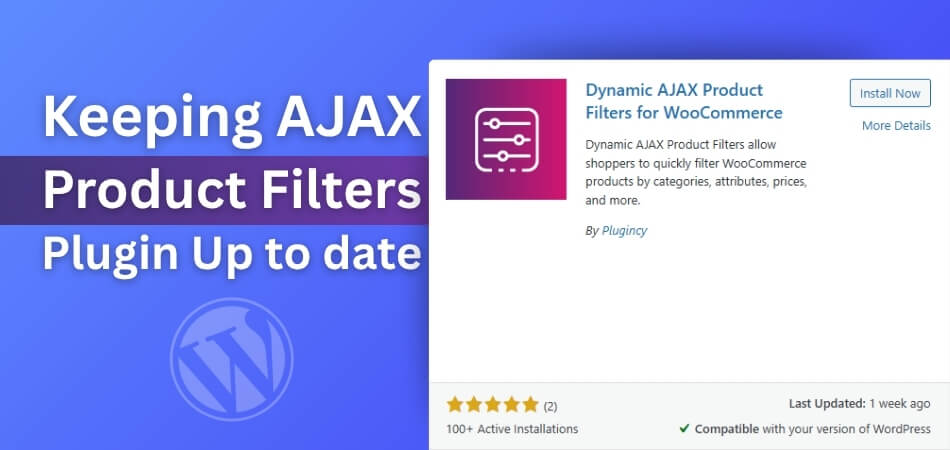
Fixes Hidden Bugs
Sometimes small bugs hide in the background without showing any obvious errors. These bugs can slowly cause your website to act weird or crash. Plugin updates usually fix these hidden problems and stop them from growing. If you ignore updates, these small issues can pile up. That’s why it’s better to let updates clear out any silent bugs before they turn into bigger problems.
Matches WooCommerce Changes
Every time WooCommerce updates, it may change how things work inside the system. If your filter plugin doesn’t match those changes, it might stop working properly. That can lead to missing products or broken filters on your site. Updating your plugin helps it “speak the same language” as WooCommerce. It keeps everything in sync and running without problems.
Keeps Site Safe
Hackers often look for weak spots in old plugins. When a plugin is out of date, it can become an easy target. Updates usually fix these weak spots and make the plugin stronger. So, if you want to protect your store and customer data, don’t skip updates. A simple update can stop a big issue before it starts.
Boosts Speed and Flow
No one likes a slow site, especially when shopping online. Over time, a filter plugin can slow down if it doesn’t get speed fixes through updates. Regular updates ensure your filter scripts remain optimized and compatible with WooCommerce updates, which is essential if you want to keep WooCommerce fast with AJAX Filters while maintaining security and performance. That’s why staying updated helps your site run smoothly and quickly.
Avoids Plugin Conflicts
Many websites use more than one plugin at a time. When one plugin is old and others are new, they can start clashing. This might cause errors, slowdowns, or even stop parts of your site from working. Updates help your filter plugin stay friendly with the others. It’s like keeping everyone on the same team by using the same playbook.
Improves Features
Plugin makers often add new features during updates. These features can make your filters easier to use or more helpful to your customers. Without an update, you won’t have access to these new tools. You also lose out on improvements that make your site better. Updating means you’re always using the best version of the plugin you installed.
How Often Should You Update the AJAX Product Filter Plugin?
Most people forget to update their plugins until something goes wrong. That can lead to slow pages or filters not working right. To keep things smooth, check for updates at least once a month. Updates often come with fixes and better speed for your website.
Waiting too long to update can make your site unsafe. Hackers often find weak points in old plugin versions that don’t get fixed. A quick update can close those weak points and keep your site safe. It’s like locking your doors before leaving home—simple but smart.
Sometimes, plugins need updates right after WooCommerce updates its system. If you don’t update together, parts of your store may stop working. So it’s good to check both updates at the same time. That way, your filters stay fast and work without any problems.
What to Avoid When Utilizing AJAX Product Filters in Your WooCommerce?
AJAX product filters can make your WooCommerce store feel faster and smoother. But just adding them isn’t enough if you don’t use them the right way. Mistakes with filters can cause problems for both you and your visitors. Let’s look at what you should avoid to keep things running the right way.
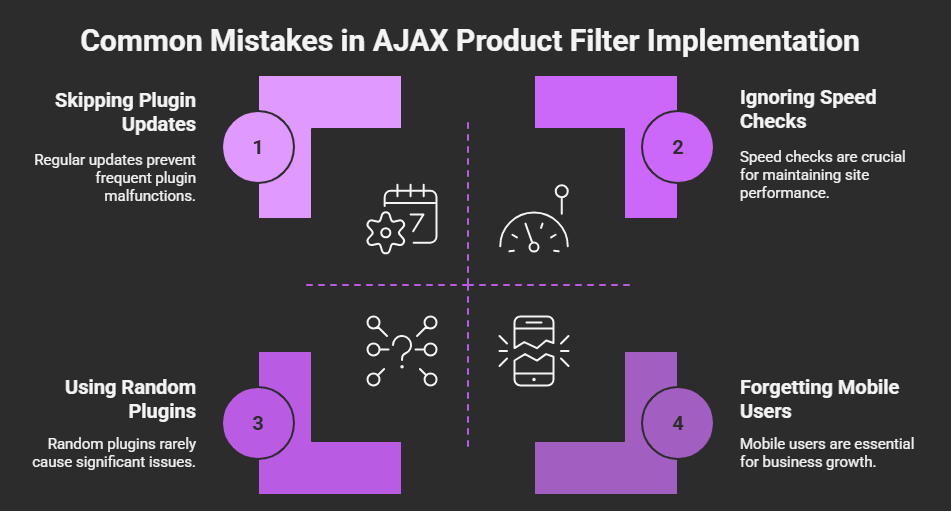
Using Random Plugins
It’s easy to pick the first plugin you see, but that’s risky. Some plugins are not well-built and can slow down your site. Others may stop working after WooCommerce updates. Always go for trusted plugins with good reviews. It saves you a lot of trouble later.
Skipping Plugin Updates
If you don’t update your plugin, things can break without warning. Filters may stop loading or show wrong results. Updates also fix bugs and improve speed. Keeping things updated means fewer problems and a smoother shopping experience. Don’t ignore those update alerts—they help more than you think.
Ignoring Speed Checks
Just because your filter looks nice doesn’t mean it runs fast. Some plugins can make your pages load more slowly. This can annoy users and even push them away from your store. Use tools to test your site’s speed after installing filters. If things feel slow, it’s time to switch plugins.
Overloading With Options
Too many filter options can confuse your users. If the filter panel looks crowded, people might leave the site. Keep it simple and clear, like by price, color, or size. Simple filters help people find what they want faster. Less clutter leads to better results.
Not Testing Features
After installing your filters, always test how they work. One of the common issues store owners face is the reasons product filter not appearing in WooCommerce, which often comes down to simple setup mistakes. Try checking the filters on different devices and browsers. Catching small problems early can save you time and make your store look more professional.
Forgetting Mobile Users
A lot of people shop using their phones. If your filters don’t work on mobile, you’ll lose many visitors. Make sure your filters adjust to small screens. Always test them on both phones and computers. Good mobile support is a must today.
Mixing With Bad Themes
Some themes don’t support AJAX filters very well. This can cause bugs or filters that don’t show results. Choose a theme that works smoothly with filtering plugins. If things don’t fit well together, your whole site can feel broken. Always check for theme compatibility first.
Essential Tips on Customizing AJAX Filters for Better UI
Customizing AJAX filters the right way can make your WooCommerce store look clean and work better. A good design helps users find what they want faster. You don’t need anything fancy—just smart and simple changes. Let’s look at easy tips to make your filters work and look better:
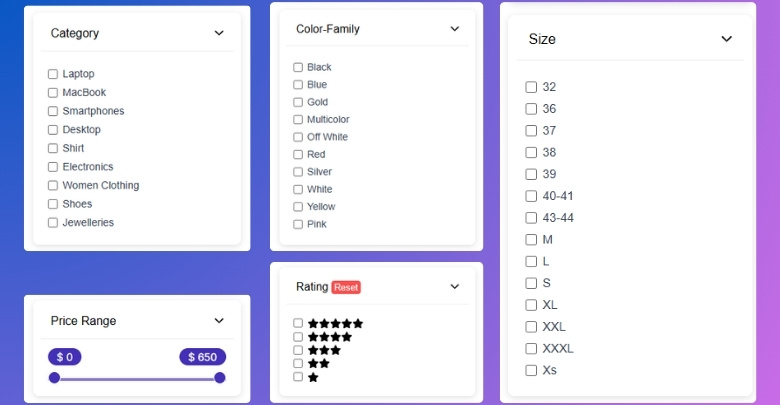
Keep It Simple
Too many filter choices can confuse people. Stick with the options your customers really need, like size, price, or color. When filters are clean and simple, people find products faster. A busy filter area can feel messy and hard to use. Less clutter makes everything easier to understand.
Use Clear Labels
People should know what each filter does just by reading it. Avoid fancy words or unclear labels that make users guess. Use easy words like “Sort by Price” or “Filter by Size.” This keeps your filters friendly and simple. Clear text helps users make quick decisions.
Make It Mobile-Friendly
Lots of people shop on their phones, so filters should work well on small screens. Test the filter section to see how it looks on mobile. Make sure it’s easy to tap and scroll through. If it’s hard to use on a phone, many people might leave. Good mobile design keeps more visitors around.
Choose the Right Layout
A messy layout makes filters hard to use. Use dropdowns, sliders, or checkboxes in a clean way. Place the filters where users can see them easily, like on the left side or top. Don’t hide filters behind extra clicks. A good layout helps users shop without getting lost.
Use Color Carefully
Colors should make filters stand out without hurting the eyes. Use soft, easy-to-read colors for buttons and text. If something is selected, highlight it clearly so users know. Avoid using too many colors that clash. A calm design feels nicer to look at.
Test Before Going Live
Try using the filters yourself before adding them to your live store. Check how they work and look on different screens. Ask a friend to test them too. If something feels slow or confusing, fix it first. Testing helps catch small problems early.
Frequently Asked Questions
You might still have some questions about using AJAX product filters on your WooCommerce store. That’s completely normal. These tools can be super helpful, but it’s good to fully understand how they work, what they affect, and how to get the best out of them. Below are some of the most common FAQs that haven’t already been covered, to help clear up any remaining confusion.
Can AJAX Filters Impact Checkout Pages?
AJAX filters usually don’t affect checkout pages directly, but poorly coded plugins can cause loading conflicts. This may lead to errors or missing fields during checkout. Always test the full shopping flow before making your site live. That way, you’ll catch any issues early.
What Makes an AJAX Filter Plugin Reliable?
A reliable AJAX plugin is regularly updated, has good user reviews, and works well with most themes. It should not slow your site or break layout features. Trusted developers also fix bugs quickly, which adds to the plugin’s long-term stability.
Which Type of Stores Benefit Most From AJAX Filters?
Stores with large product ranges benefit most from AJAX filters. Clothing, electronics, and beauty stores use them to help users quickly narrow down choices. With filters, shoppers avoid endless scrolling and can instantly find items that match their preferences.
How to Know If Your Filters Are Working Properly?
You can check this by testing filters across different pages, products, and devices. Make sure results show instantly without errors. Also, watch for missing images or slow loading. A properly working filter shows only the right products and loads smoothly.
What Is the Best Way to Place Filters on a Page?
The best place for filters is usually on the left sidebar or at the top of product listings. These spots are easy to notice and use. Hiding filters in menus can lower their visibility. Easy access always improves the shopping experience.
How Do You Troubleshoot Filter Errors?
Start by disabling other plugins one by one to check for conflicts. Clear the site cache and check your theme’s compatibility. Most filter errors come from clashes between plugins or outdated code. Fixing them early keeps your store running smoothly.
Which Filter Style Works Best for Small Stores?
Small stores should stick with simple filters like price, category, and availability. Too many options can feel overwhelming. A clean design with basic filtering keeps things easy for shoppers. You don’t need fancy tools to make filtering helpful.
What Should You Do If Filters Show No Results?
First, check your product tags, categories, and attributes. Filters won’t work if products aren’t properly organized. Also, look at the plugin settings to see if anything is misconfigured. A “no results” message usually points to missing or mismatched data.
Conclusion
It’s no secret that fast and easy shopping makes customers happy, and that’s exactly what AJAX product filters bring to your WooCommerce store. But speed alone isn’t enough. The way you set up and manage your filters plays a big part in keeping everything running safely and smoothly.
So, are AJAX product filters safe for WooCommerce sites? Yes, they are—if you use trusted plugins, keep everything updated, and avoid common mistakes. Just like any tool, they work best when handled with care and attention.
With the right setup, these filters won’t just improve user experience—they’ll also help your store perform better. Keep things simple, stay updated, and always test before going live. Small steps like these can make a big difference.
